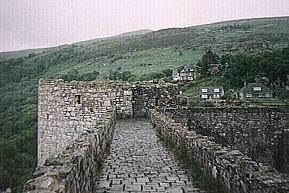

As if its spectacular situation, foreboding might, and great power were not sufficient to ensure the fame of this magnificent castle, Harlech is also inseparably linked in Welsh myth with the tragic heroine of Branwen, the daughter of Llyr, of the Mabinogion. Mythology aside, it is small wonder that this is one of the most familiar strongholds in Britain. Seen from the bluff of rock to the south of the town, the view of castle, sea and mountain panorama is truly breathtaking. But not only has it an unsurpassed natural setting, as a piece of castle-building Harlech is also unrivalled. Even after seven centuries, it remains a testament to a military architect of genius, Master James of St. George. Here he adapted the natural strength of the site to the defensive requirements of the age, and created a building which combines a marvellous sense of majesty with great beauty of line and form.
Harlech was begun during King Edward I's second campaign in north Wales. It was part of an "iron ring" of castles surrounding the coastal fringes of Snowdonia, eventually stretching from Flint around to Aberystwyth; a ring intended to prevent the region from ever again becoming a focal point of insurrection and a last bastion of resistance. Following the fall of the Welsh stronghold of Castell y Bere, King Edward's forces arrived at Harlech in April, 1283, and building work began almost immediately. Over the next six years an army of masons, quarriers, laborers and other craftsmen were busily engaged in construction. In 1286, with the work at its height, nearly 950 men were employed under the superintendence of Master James. The final result was a perfectly concentric castle, where one line of defenses is enclosed by another. Unfortunately, the outer wall is ruinous today and fails to convey the true 13th-century effect.
The natural strength of the castle rock and cliff face meant that only the east face was open to possible attack. Here the gatehouse still offers an insolent display of power. The gate-passage itself was protected by a succession of no less than seven obstacles, including three portcullises. On either side of the passage were guardrooms, and the upper floors of the gatehouse provided the main private accommodation at Harlech. The first floor must have been for the constable, or governor, who from 1290-93 was none other than Master James himself. The comfortable rooms on the top floor probably served as a suite for visiting dignitaries, including the king.
The inner ward is surprisingly small and, as the foundations show, a great deal of room was originally taken up by the surrounding ranges of domestic buildings. To the rear lay the great hall and kitchen. Against the north wall were a chapel and bakehouse, and to the south a granary and a second hall. The corner towers provided further accommodation, and today the visitor may care to climb one of the sets of steps to the wall-walks from which there are superb views in all directions.
The castle's other remarkable feature is the defended "Way from the sea," a gated and fortified stairway plunging almost 200 ft down to the foot of the castle rock. Once, this gave access to supplies from the sea, but the tide level has since receded, leaving Harlech somewhat isolated upon its rock. During Madog ap Llywelyn's uprising of 1294-95, this maritime lifeline proved the savior of the garrison, which was supplied and victualled by ships from Ireland.
Harlech Castle played a key role in the national uprising led by Owain Glyndwr. After a long siege, it fell to his forces in 1404. The castle became Glyndwr's residence and headquarters, and one of the two places to which he is believed to have summoned parliaments of his supporters. It was only after a further long siege in 1408 that Harlech was retaken by English forces under Harry of Monmouth, later Henry V.
Sixty years later, during the War of the Roses, the castle was held for the Lancastrians until taken by Lord Herbert of Raglan for the Yorkist side. It was this prolonged siege which traditionally gave rise to the song Men of Harlech.
 Inside shot of
Gatehouse
Inside shot of
Gatehouse  The
Ruins of the Great Hall
The
Ruins of the Great Hall  What
remains of the Kitchen and
What
remains of the Kitchen and
 On
top of the Inner Wall
On
top of the Inner Wall  Inner
wall walk, shot
2
Inner
wall walk, shot
2  Inside of gatehouse, From wall walk
Inside of gatehouse, From wall walk
 Ruins
of the
Chapel
Ruins
of the
Chapel  Large
view of wall walk
Large
view of wall walk  Large
view of Harlech's west side
Large
view of Harlech's west side
 Floor
Plan of the Castle
Floor
Plan of the Castle
 Overview
of 3D World
Overview
of 3D World
Return to Artist Statement Visit Harlech, Circ. 1295
All Pictures and descriptions copyright of their respective owners; reproduced from CADW, and http://www.castlewales.com/harlech.html